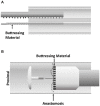New Technologies to Prevent Anastomotic Leak
- PMID: 34853558
- PMCID: PMC8610641
- DOI: 10.1055/s-0041-1735268
New Technologies to Prevent Anastomotic Leak
Abstract
Leaks from anastomoses can be a serious complication of any gastrointestinal resection. Leaks lead to increased morbidity, delayed postoperative recovery, and potential delays in adjuvant treatment in cancer cases. Prevention of anastomotic leak has been an area of ongoing research for decades. Methods of assessing bowel perfusion have been developed that may provide forewarning of anastomotic compromise. Physical reinforcement of the anastomosis with buttressing material is an available method employed with the goal of preventing leaks. Liquid-based sealants have also been explored. Lastly, interactions between the gut microbiome and anastomotic healing have been investigated as a mean of manipulating the microenvironment to reduce leak rates. Though no single technology has been successful in eliminating leaks, an understanding of these developing fields will be important for all surgeons who operate on the gastrointestinal tract.
Keywords: anastomosis; anastomotic leak; bowel perfusion; colorectal surgery; endoscopy.
Thieme. All rights reserved.
Conflict of interest statement
Conflict of Interest None declared.
Figures



Similar articles
-
Management of anastomotic leak: lessons learned from a large colon and rectal surgery training program.World J Surg. 2014 Apr;38(4):985-91. doi: 10.1007/s00268-013-2340-y. World J Surg. 2014. PMID: 24305917
-
Equivocal effect of intraoperative fluorescence angiography on colorectal anastomotic leaks.Dis Colon Rectum. 2015 Jun;58(6):582-7. doi: 10.1097/DCR.0000000000000320. Dis Colon Rectum. 2015. PMID: 25944430
-
Bioabsorbable staple line reinforcement in restorative proctectomy and anterior resection: a randomized study.Dis Colon Rectum. 2014 Mar;57(3):324-30. doi: 10.1097/DCR.0000000000000065. Dis Colon Rectum. 2014. PMID: 24509454 Clinical Trial.
-
Defining Anastomotic Leak and the Clinical Relevance of Leaks.Clin Colon Rectal Surg. 2021 Oct 1;34(6):359-365. doi: 10.1055/s-0041-1735265. eCollection 2021 Nov. Clin Colon Rectal Surg. 2021. PMID: 34853555 Free PMC article. Review.
-
Management of low colorectal anastomotic leak: Preserving the anastomosis.World J Gastrointest Surg. 2015 Dec 27;7(12):378-83. doi: 10.4240/wjgs.v7.i12.378. World J Gastrointest Surg. 2015. PMID: 26730283 Free PMC article. Review.
Cited by
-
Fibrin glue and coats compromise the integrity of colonic anastomosis: an experimental trial on rats.Ann Gastroenterol. 2024 Mar-Apr;37(2):216-224. doi: 10.20524/aog.2024.0859. Epub 2024 Feb 18. Ann Gastroenterol. 2024. PMID: 38481780 Free PMC article.
-
Asymmetric figure-of-eight single-layer suture technique for intestinal anastomosis: A preliminary study.Front Surg. 2023 Feb 13;10:1109751. doi: 10.3389/fsurg.2023.1109751. eCollection 2023. Front Surg. 2023. PMID: 36860948 Free PMC article.
-
Laser tissue soldering of the gastrointestinal tract: A systematic review LTS of the gastrointestinal tract.Heliyon. 2023 May 1;9(5):e16018. doi: 10.1016/j.heliyon.2023.e16018. eCollection 2023 May. Heliyon. 2023. PMID: 37205994 Free PMC article. Review.
-
Poly-ϵ-caprolactone scaffold as staple-line reinforcement of rectal anastomosis: an experimental piglet study.BMC Gastroenterol. 2024 Mar 15;24(1):112. doi: 10.1186/s12876-024-03202-1. BMC Gastroenterol. 2024. PMID: 38491416 Free PMC article.
References
-
- Urlesberger H, Rauchenwald K, Henning K. Fibrin adhesives in surgery of the renal parenchyma. Eur Urol. 1979;5(04):260–261. - PubMed
-
- Oka H, Harrison R C, Burhenne H J. Effect of a biologic glue on the leakage rate of experimental rectal anastomoses. Am J Surg. 1982;143(05):561–564. - PubMed
-
- Houston K A, Rotstein O D. Fibrin sealant in high-risk colonic anastomoses. Arch Surg. 1988;123(02):230–234. - PubMed

